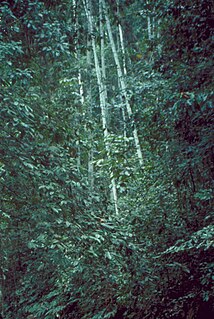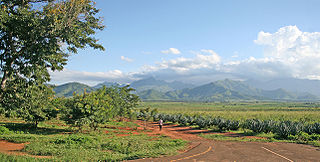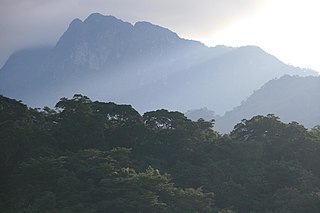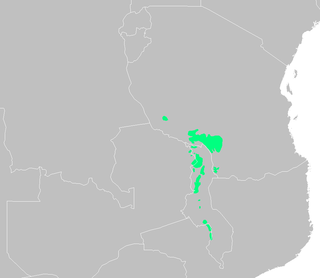
The Eastern or 'East African Highlands' is a mountain range in the east of Zimbabwe and one of four distinct physiographic divisions on the African continent. It extends for about 300 kilometres (190 mi) along Zimbabwe's eastern border with Mozambique.
The Mahenge Mountains are a mountain range in Ulanga District, Morogoro Region, Tanzania. The town of Mahenge is located in the northeastern mountains. The mountains are southeast of Iringa, in the Eastern miombo woodlands ecoregion.
The Nguru Mountains are a mountain range in Morogoro Region, Tanzania, Africa. The Nguru Mountains are part of the Eastern Arc Mountains. The mountains are predominantly covered with rainforest, home to 83 species of birds and African violets. There are a number of forest reserves in the mountains.
The Udzungwa Mountains are a mountain range in south-central Tanzania. The mountains are mostly within Iringa Region, south of Tanzania's capital Dodoma. The Udzungwa Mountains are part of the Eastern Arc Mountains, and are home to a biodiverse community of flora and fauna with large numbers of endemic species.

The Amani Nature Reserve is a protected area located within the Muheza and Korogwe Districts in the Tanga Region of Tanzania, in tropical East Africa.
The Taita Hills, sometimes also spelled as Teita Hills, are a precambrian mountain range located in the Taita-Taveta County in south-eastern Kenya. The hills consist of three massifs: Dabida, Sagalla in the southern side of Voi township and Kasigau in the south near the border of Tanzania. The Dawida massif is the largest and tallest of the three, with an altitude of 2,228 metres (7,310 ft) above sea level at its highest peak, Vuria. Dabida has three other main peaks: Iyale, Wesu, and Susu.

The Cameroonian Highlands forests are a montane tropical moist broadleaf forest ecoregion located on the range of mountains that runs inland from the Gulf of Guinea and forms the border between Cameroon and Nigeria. This is an area of forest and grassland which is becoming increasingly more populous as more and more land is cleared for agriculture.
The dark batis is a small passerine bird belonging to the genus Batis in the wattle-eye family, Platysteiridae. It is found in highland forest in south-west Tanzania and northern Malawi. These birds were formerly thought to be forest batises but in 2006 were described as a new species based on differences in morphology and mitochondrial DNA from those birds in northern Tanzania and Kenya.

Udzungwa Mountains National Park is a national park in Tanzania with a size of 1,990 km2. The habitats contained within the national park include tropical rainforest, mountain forest, miombo woodland, grassland and steppe. There is a vertical height range of 250–2,576 metres, which incorporates the Udzungwa Mountains part of the Eastern Arc Mountains. There are more than 400 bird species, 2500 plant species and 6 primate species. It has the second largest biodiversity of a national park in Africa.
Callulina shengena is a species of frogs in the family Brevicipitidae. It was discovered in 2010 during a survey of rainforests in the northern part of the Eastern Arc Mountains of Tanzania. It is present at two locations in Chome Forest Reserve at altitudes between 1,920 and 2,100 m. The forests in which it lives are being selectively felled, and the International Union for Conservation of Nature has rated its conservation status as "critically endangered".
Callulina stanleyi is a species of frogs in the family Brevicipitidae. It was discovered in 2010 during a survey of rainforests in the northern part of the Eastern Arc Mountains of Tanzania. It was named in honour of the American zoologist, William T. Stanley, of the Field Museum, Chicago, who has done much research into the amphibians of Tanzania. It is present at three locations along the eastern border of Chome Forest Reserve at altitudes between 1,100 and 1,300 m. It is rated as "critically endangered" by the International Union for Conservation of Nature.
The Rubeho Mountains are a mountain range in central Tanzania. The mountains in Dodoma and Morogoro regions, southeast of Tanzania's capital Dodoma. The Rubeho Mountains are part of the Eastern Arc Mountains, and are home to a biodiverse community of flora and fauna with large numbers of endemic species.
The Ukaguru Mountains are a mountain range in central Tanzania. The mountains are in Morogoro region, east of Tanzania's capital Dodoma. The Ukaguru Mountains are part of the Eastern Arc Mountains, and are home to a biodiverse community of flora and fauna with large numbers of endemic species.
The Nguu Mountains are a mountain range in Tanga Region of Tanzania. The Nguu Mountains are part of the Eastern Arc Mountains. The mountains are covered in woodland, grassland, and forest.















